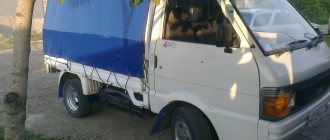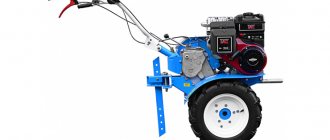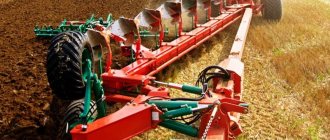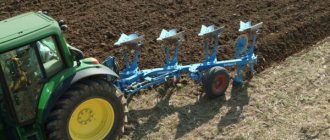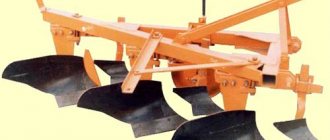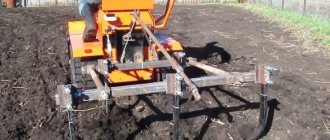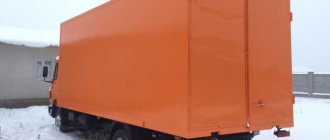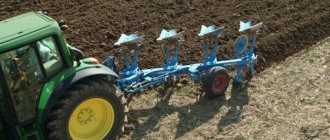A plow is a labor tool designed for plowing hard soil and has been used by man since ancient times. The intended use of a plow determines its technical and quality characteristics: the design of the frame and cutting element, fastening mechanisms and stops, material of manufacture and its thickness.
General characteristics
There are several types of plows according to their purpose:
- manual - for plowing soft land of a small area;
- horse-mounted - used in situations where it is necessary to cultivate land, access to which is limited for special equipment;
- with rope traction - helps to cultivate the soil in hard-to-reach places, for example, in the mountains or in a swamp;
- mounted – works in conjunction with special equipment, allows you to reduce the turning radius during sequential plowing;
- trailed – general purpose plow.
The mentioned types of plows, in turn, are divided into the following subspecies:
- single-hull;
- double-hull or more;
- disk - reversible;
- rotary.
The generally accepted configuration of a plowing tool, which you can construct with your own hands, is shown in Figure 1.
The main parts of the hull structure have the following parts:
- chisel – pad on the cutting part;
- ploughshare – removable “knife”;
- wing, chest and blade feather;
- uglosnim – cuts corners from layers of soil;
- stand – fastening element.
Modern technologies make it possible to make a plow with your own hands. You can design it according to your drawings or modify a ready-made one to suit your needs. A tool made independently has a number of advantages and characteristic design features.
Features of a homemade model
A plow assembled with your own hands is a tool that meets target needs and has a low cost. To assemble it, you can use materials available, as well as parts of the structures of other agricultural units. The latter can be taken from old agricultural workshops, ferrous metal collection points, and other similar places.
A homemade plow can be easily adjusted to suit your needs. It is possible to adapt it to different types of soil, draft mechanisms, and even to the functions of processing agricultural crops. Your own plow can be manufactured taking into account the power and productivity of tractor equipment, which will allow you to achieve the highest efficiency and reduce destructive loads on the plowing tool.
The cutting element of this plow can be replaceable and manufactured/sharpened independently, which significantly reduces the cost of servicing the mechanism. With independent production, it becomes possible to vary the intended use - introducing the function of replaceable elements: nozzles, fasteners, parts of the body and frame. This allows for combined work, such as plowing and mowing bushes.
When making your plow, you can pay special attention to the choice of materials and their quality. This is one of the key advantages of homemade assembly, since when buying a plow in a store, it is difficult to be sure of the quality of the metal used to manufacture the factory unit. After purchasing a store model, you may need to further refine it or replace some low-quality structural components.
Design features
A design feature of the disc harrow that distinguishes it from analogues produced in the CIS countries is the location of each disc on a separate axis. Thanks to this improvement, you can easily adjust the angle of attack of the cutting element and the width of the soil layer.
At the same time, the disk performs two functions - a ploughshare and a blade, this facilitates the turnover of the earth layer and its crumbling. As a result, the required traction force of the equipment is reduced and fuel consumption is reduced.
A well-designed harrow does not require batteries to be installed on a single axle. The mechanism is designed taking into account the characteristics of wet soils, so field work can be carried out on wet and rainy days. It is possible to cultivate land that is overgrown with weeds or with a large amount of residue after harvest.
The mechanism is designed in such a way that it prevents clogging of the rows and contamination of the axle with roots and stems of weeds. During operation of the harrow, mechanical self-cleaning of the disc occurs, so installation of scrapers is not required.
The mechanism demonstrates high operating efficiency in small areas with complex terrain, where high maneuverability is required.
Materials and tools
Making a homemade plow for a mini-tractor requires the following basic tools:
And an additional tool, the list of which is determined by the design of a particular mechanism and the conditions of its production.
The materials making up the main structure must be solid steel blanks. Violations of their integrity - cracks, deformation, severe rust - are unacceptable.
List of materials that may be needed:
- thick-profile sheet metal of high strength;
- metal corners and plates of sufficient thickness;
- bolts of various calibers;
- additional items (washers, bearings, springs) determined by the characteristics of a particular design.
How to do it?
In order to facilitate the process of assembling a plow for a mini-tractor, you can go by reconstructing another tool of the same name, used in conjunction with draft objects: a horse-drawn plow or a skimmer from the plowing mechanism of a large tractor.
Assembling the required unit requires drawing up the correct drawings. Their presence will ensure optimization of the design, reduction in the number of components, simplicity and quality of assembly.
The drawings should indicate the dimensions of the elements, which are closely related to the dimensions of the mini-tractor and the properties of the cultivated soil. During the manufacturing process, it is important to adhere to these parameters.
At the design stage, it is worth drawing separately each detail that has an irregular shape, respecting its natural size. In the future, from such drawings it will be possible to create a pattern for transferring the image of the part onto a metal workpiece. Some variations of the plow drawing are shown in Figures 2 and 3.
Let's consider two options for making a plow for a mini-tractor.
From a horse plow
This plow configuration, mounted with a mini-tractor, is considered the easiest to manufacture. All work on reconstructing a horse-drawn plow comes down to adapting to it a frame that has a special fastening mechanism, equipping it with a wheel (if necessary) and a weighting agent.
A horse-drawn plow consists of a body and a double-sided frame, which serves as a mechanism for attaching to the animal's harness and as a means of controlling the plowing process. Its simplest configuration is shown in photo 4.
In this case, it is necessary to reconstruct the mounting part of the horse-drawn plow into one that will be installed on a mini-tractor with the least effort. This process can be simplified by making a tow bar for a tractor mount. A copy of it is shown in photograph 5.
The towing device is easy to manufacture. A wide plate, which has two horizontal holes with internal threads at the edges, is complemented by a protrusion in the middle, into which a fork ball with a leg is screwed/welded. An L-shaped part is attached to the center of the plate, serving as a locking mechanism for the plow frame mounted on the tow bar. The plate is placed between the two “ears” of the tractor mount and secured with four bolts.
The modification of the horse-drawn plow shown in photograph 4 is equipped with a special wheel. It serves as a support for the structure frame; it can be used to adjust the depth of penetration of the plow into the soil.
Adjustment is carried out using a simple mechanism - a threaded bracket into which a clamping bolt is screwed. The wheel stand can move vertically inside the bracket. The bolt fixes it in the desired position. This design allows, if necessary, to move the bracket along the plow frame.
Read also: Wood for turning works
The wheel itself is made of a metal rim, spokes and an axle drum. To make it, you can use a 300x50 mm metal strip, reinforcing bars, or a piece of pipe with a diameter equal to the diameter of the wheel axle.
The metal strip is bent in the form of a hoop, its edges are welded together, the weld seam is ground with a grinder or cutting wheel of an angle grinder. A piece of pipe equal to the width of the tape is placed in the center of the circle. The distance from the rim to the outer surface of the pipe - drum is measured. The reinforcement spokes will be equal to this distance. The resulting blanks are welded together. To improve the torsion characteristics of the wheel, a bearing of the appropriate diameter can be welded into the drum. This will reduce friction and reduce the load on the wheel axle.
The described plow design can be operated in two ways. In the first case, a second person will be needed to control the plow from behind, adjusting the furrow line. In this case, the “manager” applies pressure on the frame necessary for sufficient immersion of the ploughshare into the ground.
In the second case, the presence of an assistant is not necessary. The plow becomes heavier and moves on its own. The load can be a piece of heavy metal or a stone enclosed in a frame. The weighting agent is placed on the edge away from the tractor. In this case, the pressure on the share will be maximum with the available weight. To prevent the load from overturning the plow, it should be secured on the underside of the frame.
When operating a plow without a second person, it is worth considering the factor of furrow curvature. The simplicity of the described design assumes that the plow “swims” from side to side. To eliminate this problem, it is necessary to equip it with a “hard” clutch with the tractor. In this case, the draft mechanism will straighten the furrow strip.
From skimmers
A skimmer is an element of a tractor plow that serves to cut off the top layer of soil during plowing. Photo 6.
Its shape is similar to the working body of a plow share, and its size is half the size. This fact allows you to effectively use the skimmer as a plow for a mini-tractor.
During the design process, you will need to weld a frame that will hold the skimmer and attach it to the tractor towbar, and also equip it with a stop wheel.
When creating drawings of this design, it is worth taking into account the power of the tractor, the condition of the cultivated soil, and the volume of future work. If you plan to plow a large area of land, you can use two skimmers on one frame. In this case, the plow will have a double body. This is necessary in order to reduce the load on one plowshare body and reduce its wear.
The process of assembling the structure and installing it on a tractor is similar to reconstructing a horse-drawn plow. A frame of a similar configuration, a wheel, fastenings for the ploughshare stand and the entire structure to the towbar are made. A weighting device or control handles are installed for manual correction of the furrow.
Specifications
There are several types of hulls and all models differ in appearance. Let's get to know them.
Disc huller LDG
This type of peeler is considered the most popular. The high level of challenges facing this model is explained by its practical uniqueness.
LDG-5
The presented type has a frame base with attached rotating disks. On LDG-5 there is the ability to regulate the angle of attack and increase the depth of immersion.
LDG-10
A type of peeler that consists of 2 whole metal frames. The frames work synchronously. The base consists of pointed concave disks with a diameter of 450 mm. The main indicators are adjusted using the pressure spring bolts. The main distinguishing feature of the LDG-10 is its increased coverage capability, which leads to increased tractor power.
LDG-15
The model has similarities with the above types. A disk battery has been added to this model. The battery is attached at the intersection of the two grids. The use of a battery makes difficult-to-reach areas accessible to other sections of the hoe.
Hull harrows "Dukat"
Agricultural machine for cultivating land. This huller is produced domestically. "Dukat" is a very popular agricultural device in agriculture. The most important distinguishing characteristic of Dukat is its versatility.
We recommend: How does a corn husk work?
The area of use is the impact on the most overgrown areas of the earth. Harrowing the soil with a Dukat harrow serves as an excellent way to access oxygen; active cultivation of plant remains will serve as the best nutrient medium for cultivated plants.
Dukat harrow harrows are excellent machines that are suitable for cultivating land areas where it is planned to grow grain crops, as well as crops intended for feed and technical processing.
These “Dukat” disc harrows productively destroy ornamental plants and harrow the soil for annual grain crops. They are used to apply funds to control ornamental plants and improve the quality of soil for pastures.
Peeler Heliodor
The compact size Heliodor disc harrow is ideal for flat stubble cultivation on light and medium soil, as well as for pre-sowing soil treatment for mulching or after plowing.
Thus, the device has received many-sided applications, both in traditional technologies and in sowing technologies in mulched soils. Increased work speed with reduced power requirements allows for increased productivity.
With the help of a stable stand in the form of a leaf spring, Heliodor can also work on rocky soil constantly and without being clogged with stones.
The huge, curved 465mm discs are mounted on maintenance-free axial thrust ball bearings with a special labyrinth seal to keep dust and dirt out.
Due to its low weight, Heliodor is distinguished by the fact that devices of 3-6 m can be easily mounted with a three-point hitch on a tractor.
Semi-mounted devices of 4-6 m are capable of working in combination with a Solitair pneumatic seeder.
Gigant system carriers have a working width of 8-12 m to guarantee quick sowing.
Peeler Dukat
Short disc harrows are used for peeling stubble; main shallow tillage; pre-sowing treatment of soil for grain, industrial or forage crops, and for preparing soil for sowing winter crops in fallow; guarantees the crushing and incorporation of plant residues from previous crops and weeds; used to improve meadows and pastures. The mounted disk hoe “DUCAT” is used in such conditions.
The short DUKAT harrow-harrows, 5-6 m wide, are foldable units, prepared for the most common tractor powers of 150-250 hp. During transfer to transport states, the 2 half-frames can be raised vertically, and the chassis system is also lowered.
The transport width of 3 m exactly corresponds to European standards, and in Ukraine it guarantees increased maneuverability and constant movement along rural and general purpose roads.
In DUKAT-5 and DUKAT-6, the distance between the disks in the longitudinal directions was increased and the load on the disk was increased (approximately 100 kg), which can improve the quality of soil treatment—3-14 cm in depth. With the help of this, they are also able to walk on harder soils and on more crop residues.
DUCAT guarantees correct maintenance of tillage depths and excellent leveling characteristics through the use of different copying systems with uniform distribution of loads across the working body, which allows for high-quality work in fields with difficult terrain.
Peeler Veles
The trailed disc harrow BDP-10 manufactured by VELES with a 2-row installation of the working body (disk) is used to loosen and prepare the soil for sowing, destroying weeds and grinding crop residue.
Two rows of cut-out discs, located at an angle to one another, are designed to crush crop residues and to disrupt the development of root systems of weeds.
Rubber shock absorbers effectively protect discs from damage.
Original conical disks manufactured by VELES. Thickness 5 mm, reliability HRC 40-45.
Several rows of rollers, which serve as compaction of the surface layers of the soil and additional destruction of crop residue structures. The crumbly and compacted structure of the soil guarantees excellent contact with plant residue, which is responsible for their rapid decomposition:
The first row of rollers can roll and break up huge clods, the second row of rollers begins to comb out crop residues.
We recommend: How can you make a peeler with your own hands?
Husker Solar Fields
Trailed cultivators LD EURO are the best option for surface tillage. Wide-cut implements of the popular category guarantee excellent quality pre-sowing preparation and loosening of the soil after harvesting various row crops or grain crops.
Disc cultivator Softer
A distinctive feature of Softer is the exclusivity of work from the first peeling of the remains of stem plants to the final preparation of the land before sowing after sandblasting or plowing the land.
Simple design with increased stability
The operating speed of the Softer 8 disc harrow with a corresponding tractor reaches 15 km/h. This allows crop residues to be incorporated into the ground at the right time.
The Softer hardware model is special for its simple structure and reliability, maximum compression and uniqueness, as well as with a minimum of necessary places for adjusting and lubricating the device. Softer Farmet discs are shaped like a chamomile, and due to the high pressure of each of them, they have the ability to easily penetrate the hardest and most dry soil.
Excellent stability and precise depth control
Due to the fact that the design of the device is quite compact, there is a very precise coarseness controller, as well as good durability during operation and high-quality quick turn at field corners.
The angle of attack of each disc and the high pressure on it create good penetration into hard, dry soil and excellent cutting. A well-executed installation of working elements with fixation by rubber devices creates a good angle of disk attack.
Safety precautions
When operating a homemade plow, appropriate safety measures must be observed. Among them, the most important points can be highlighted.
- while the plow is moving along the furrow, it is unacceptable to adjust it in height, clear the wheel and ploughshare from the earth and other manipulations associated with human participation;
- all connection points must be securely fastened - play is unacceptable;
- it is necessary to carry out timely cleaning of mechanisms and sharpening of cutting elements;
- Perform all actions only with the plow immobilized and the tractor turned off.
To ensure labor safety, it is important to carry out work that meets the technical characteristics of a specific agricultural mechanism. Excessive loads can lead to rapid wear, damage to the unit and harm to human health.
To learn how to make a plow on a mini-tractor with your own hands, see the following video.
Diskator PM 2x4
In the photo: PM-2.4x2N ShKPP
The 2x4 PM device provides for the placement of discs in two rows, which ensures thorough loosening of the soil when performing preparatory work for sowing, and also makes it easy to carry out preparatory treatment of the area after harvesting thick-stemmed crops.
Independent adjustment and row adjustment of each angle of attack of the cutting element, if necessary, improves the quality of tillage and reduces the required traction force of the tractor.
The absence of a single axis for all disks eliminates clogging of the working unit and does not require the installation of scrapers.
DIY plow drawings
After I got a self-made agricultural winch, which is used for plowing the garden, the question became: should I buy a plow or make it myself? Walking through the shops and bazaar of Smolensk, you get a strange feeling that the plows produced by the industry for walk-behind tractors are a sad sight.
And these industrial creations are suitable only for “picking” and not for plowing the land, and even with the rotation of the layer, and regarding the depth and width of plowing, we can conclude that for planting potatoes with a distance between rows of 60 cm, not one of the proposed ones is suitable in the plow trade. Either our manufacturers are saving money, or the power of the most popular walk-behind tractors is not enough to work with a normal plow with a working width of 30 cm. When planting potatoes, you shouldn’t plow one furrow three times. And the price wants to leave the best - under 2 thousand. rubles (for a couple of pieces of iron from a scrap metal collection point).
The next step to find something useful is to search the Internet. To my surprise, there are 3-4 original descriptions with drawings floating in the vastness of the Russian-language network (this fact surprises me very much). The next step is to look at what those around you are using. It was not possible to buy a suitable plow; the decision was made to make a plow with our own hands. Based on the fact that the plow was supposed to be used for planting potatoes with a winch for plowing, the following requirements are imposed on it:
1. Plowing width – up to 30 cm.
2. Plowing depth -10-20cm.
3. The plow must hold the furrow itself, without digging in or jumping out of the furrow. The geometry of the plow must ensure movement with the specified parameters without the help of a plowman.
4. Possibility of adjusting the depth and width of plowing.
5. Minimum weight and sufficient strength.
My uncle has been using his homemade motorized winch for plowing for more than 10 years and has tried several options. For the last few years, he has settled on an option optimized for a homemade motorized winch for the garden, namely for planting potatoes with a distance between rows of 60 cm. There is also a homemade hiller for a motorized winch and a homemade potato digger, all this can be viewed on the corresponding pages of the site.
Plow drawing
Field board drawing.
The blade is bent according to this template until the two profiles coincide and then welded at an angle.
Using a drawing of a homemade plow, you need to draw a template for the plow pattern on thick paper, and then transfer the picture to metal and cut out the blank with a grinder. Personally, I used stainless steel material with a thickness of 1.8 mm. Many often use a sheet of 2-3 mm. The cutting part of the plow is reinforced with a strip of thicker metal. Someone suggests using a disk from a circular machine for these purposes, or a spring from a “Muscovite”. From personal experience, if you plow a summer cottage plot for a family of 4 people in the spring and fall, cultivating six acres, you shouldn’t strive for super-strength. It is more profitable to make a plow that is light but strong enough for its tasks. It’s better to repair or replace something after 10 years, and only if necessary, than to carry around the heavy structure of a homemade plow for 10 years. There is no need for excess weight.
Read also: Manual jigsaw for figure cutting on plywood
This is what the plowing width adjustment system looks like. By rearranging the large wheel, you can change the plowing width within significant limits. When I plant potatoes, I set the grip to 30 cm, in two passes the distance between the rows is 60 cm. For autumn plowing of the garden or when plowing virgin soil, I use a smaller grip. The small wheel is made so wide that the plow does not press into the ground.
Having looked at the pictures below, you can imagine the basic principles of operation of a homemade plow, or rather a guide system that allows the plow, without the participation of a plowman, to move strictly in a straight line at the established plowing depth and width. The plowing width is regulated by moving the large wheel, which, when the point of application of the traction force is shifted as shown in the figure, is pressed against the furrow, which allows the plow to repeat the direction of the previous furrow. The plow turns slightly, which increases the plowing width. In fact, the width of the nose in the direction perpendicular to the axis of movement of the plow is less than 300 mm, however, the specified width is available for plowing.
The plow wheel runs along the bottom of the plowed furrow and this situation is observed from the previous furrow to the next. As a result of the application of traction force, a force is exerted to deepen the plow until the plow is aligned with the axis of the wheel, as shown in the figure, as a result, all forces are balanced, and the system operates very stably. Rough adjustment of the plowing depth is carried out by selecting the appropriate difference in wheel diameters, and smooth adjustment is carried out by adjusting the tilt of the plow. At this stage, there was no longer any need to use handles to control the plow, except for some special plowing conditions.
Plows not only loose soil as in the video, but also virgin soil
Plow for agricultural winch – video
The plow is used in conjunction with such a winch for plowing
You can find industrial motorized and electric winches for plows on sale.
A walk-behind tractor is a worthy replacement for mini tractors in small farms and household plots. Equipped with a diesel or gasoline engine, depending on the power, in one work shift it is capable of processing an impressive area, plowing it manually would take many times longer.
Homemade assembly of a power unit (motoblock) is impractical due to the high cost and complexity of the process. But its main working body - the plow - is a simple matter to make and assemble with your own hands, as we will see in this article.
Maintenance
Timely, regular maintenance of the paper machine extends the service life and guarantees excellent operating condition of the unit. On farms using such semi-mounted mechanisms, it is necessary to carry out maintenance in a timely and scheduled manner. It is important to always keep all components and mechanisms in good working order.
The characteristics provide for two types of maintenance - during each work shift and at the end of the work season. It is important to inspect and clean equipment before starting your shift and after forty hours of work. Some technical measures are carried out both during plowing and after it.
At the end of the field work season, it is necessary to carry out a full range of maintenance and measures to preserve the equipment for the winter period.
Plow on a walk-behind tractor: varieties and their design features
A plow is a special device for plowing the soil, equipped with a metal share.
Designed for loosening and turning over the top layers of soil, which is an important part of pre-sowing and fall treatment. Initially, plows were pulled by people, and somewhat later by farm animals. Today, a plow on a walk-behind tractor is one of the options for using this mounted auxiliary equipment, in addition to a tractor or mini tractor. Depending on the shape of the main working elements, plows on walk-behind tractors are:
- plowshares;
- dumpless;
- disk;
- rotary;
- combined.
By type of ploughshare:
- screw;
- cylindrical;
- semi-cylindrical.
Based on the number of working parts:
- single-body plow on a walk-behind tractor;
- double-hull;
- multi-hull models designed for extremely complex tasks.
In addition, plows for walk-behind tractors, according to the specifics of fastening, are divided into conventional and reversible.
Advantages of disk models
The stubble hoe has the best performance compared to the ploughshare hoe.
- Cultivation of the top part of the soil is carried out regardless of natural phenomena.
- The cutting disc self-cleans as it moves.
- Reducing friction during movement leads to savings.
- The probability of disk failure is minimal.
- The penetration depth of the discs is the same;
Disc cultivators are machines with many functions that save time and improve results.
How to make a plow on a walk-behind tractor with your own hands?
A plow on a walk-behind tractor with your own hands is not a transcendental thing, but quite real. Thanks to proven drawings and high-quality materials, this process is reduced to several successive stages, ultimately resulting in a unit with low cost and high production resource.
The plow for the walk-behind tractor shown in the drawing is considered universal. In order to make a homemade plow for a walk-behind tractor, you need to remember the following nuances:
- deviation from the standard dimensions of a proven design may result in breakdown of the unit;
- for a plow it is worth considering a mounting stand that would allow it to be adjusted and installed on the walk-behind tractor itself. It is best to choose all-metal plates 1 cm thick for these purposes. By adjusting the stand, you can set the desired plowing depth;
- the blade must withstand heavy loads. For this, the most suitable material would be sheet steel of standard thickness. The main thing is not to overdo it with the bend. It is advisable to use a gas heater to heat the pipe and bend it in the direction required according to the drawing or workpiece;
- ploughshare - a composite plow mechanism that directly interacts with the ground, preferably made of high-alloy steel or a special grade of steel “Sormite”. The difference in the thickness of the top and bottom layers will ensure uneven grinding and long-term work without sharpening.
Let's consider some options for a homemade plow on a walk-behind tractor.
Reversible plow for walk-behind tractor: do it at home
The reversible (reversible) plow to the walk-behind tractor is externally distinguished by its curved shape, which helps turn the top layer of soil by 1800. It has gained enormous popularity on hard soils, where conventional loosening does not bring the expected result. Its device is the most complex among other varieties.
A universal version of a reversible (reversible) plow is shown in the figure.
The size of the structural elements is detailed in the drawing.
To invent it you will need to do (notations according to the drawing):
- plowshares (a) made of steel. It is desirable that they be removable for possible sharpening or modernization. The cutting part is processed on an anvil and sharpened. The lower one is designed for cutting into the soil, the upper one turns over the cut layer. The strength of the latter can be strengthened with a corner welded to it;
- form a dump, there are several ways to do this. According to one of them, a steel pipe with a diameter of no more than 6 cm is taken, to which a cardboard blank is attached. There should be about 20 0 between the generatrix of the pipe and the stencil;
- side part of the stand (b);
- spacer plate (c);
- base of the product (d);
- corner (d);
- stand (e).
The diagram shows the assembly sequence of the rotary plow, where 1 is the share, 2 is the side part of the stand and 3 is the auxiliary sheet.
A variation of the standard reversible plow is the Zykov rotary plow, the distinctive feature of which is the reinforcement of the plowshares with steel blanks on bolted ties and a large angle of attack. An additional wheel can be used to ensure structural stability.
In the proposed drawing it is highlighted in yellow.
Rotary plow on a walk-behind tractor: advantages of the unit
It has the most advanced form for plowing virgin soil and areas overgrown with weeds to a depth of about 30 cm. A homemade rotary plow includes:
The walk-behind tractor on which such a tool is mounted must have a working power take-off shaft. It is he who drives the axle, and she – the plowshares.
Read also: How to dissolve frozen polyurethane foam
Homemade rotary plows for walk-behind tractors are most often found with disk mechanisms. But drum, blade and auger plows are also known. Indispensable for applying fertilizers and controlling weeds.
Advantages of 4-row PM harrows compared to 2-row ones
The distance between the working elements in each row is 46 cm, between the rows – 67.5 cm. These dimensions ensure easy passage of the thrown soil on soils of any degree of complexity and humidity, except rocky ones. Thanks to well-thought-out technical characteristics, four-row harrows can be successfully used for processing areas with high weeds, providing greater plowing depth.
The length of the frame is designed in such a way as to eliminate, smoothing out, small irregularities in the plowed field. Using a four-row harrow, you can level the site, smoothing out the high ridge of the slope and furrows, eliminating deep ruts and recesses that may occur after processing in areas with complex terrain.
Four-row machines are the best solution for cultivating complex, fallow fields.
DIY disc plow
A disk plow on a walk-behind tractor or a hiller plow is a special device used for cultivating the soil before planting tuber crops. Lays furrows for planting potatoes, beets, celery, and hills them.
Below is a diagram and drawing of the hiller
Its structure includes:
- 2 – disks;
- 3 – fist;
- 4 – bracket;
- 5 – axis;
- 6 – scraper;
- 7 – driving beam;
- 8 – screed;
- 9 – handle.
The number 1 indicates the work area.
Discs can be taken from an old seeder. Their installation is carried out at an angle to improve the productivity of arable work. Attaching the hiller to the walk-behind tractor through the hitch bracket. The T-shaped plow leader is screwed to it with bolts and a stopper. At high speed, the hiller may begin to slip. Therefore, you need to work with it only at low speeds or with paired wheels.
According to another instruction, the disk plow for the walk-behind tractor begins to be assembled by cutting out an equilateral corner. The toe is welded to it, and then through the thrust bar and the heel. The discs are mounted on special hinges, which are welded to ensure their symmetrical position to the common axis.
Purpose
It is known that the most popular is the plowshare plow, which is designed for cultivating soil at all stages of its cultivation. However, the use of such a tool in difficult conditions - in wetlands, areas of uprooted forest, rocky ground or heavy soils, areas with overgrown vegetation, weeds - is impractical.
Firstly, it will be impossible to achieve a high-quality result - the device simply will not cope and will get stuck. Secondly, the risk of device breakdown increases, the cost of its maintenance and the amount of fuel required to operate the drive mechanism increase.
In difficult conditions, it is preferable to use a disc plow. If a plowshare tool, encountering an obstacle, sinks into the ground or breaks, then its disk counterpart will calmly roll over the obstacle and continue to do its job.
The scope of its application is wide - from after seasonal soil cultivation to stubble peeling in order to destroy and prevent the appearance of pests and weeds. It is also used in forestry and fire departments: here they plow the ground to prevent it from spreading deep into the forest zone or getting close to populated areas.
Do-it-yourself plow to a walk-behind tractor from a horse-drawn tiller
An equally viable idea is to recycle an old horse-drawn plow into a walk-behind tractor. A full description of the process is given in the video.
A feature of all horse plows without exception is their heaviness, created by a bulky moldboard. If such a plow is installed on a walk-behind tractor without modification, the ground will not tilt.
This is a big plus, since the horse plow share will not undergo any changes.
To make a plow from a horse horse into a walk-behind tractor you will need:
- make your own blade, which is cut according to a pre-drawn drawing from a steel blank (3 cm thick). For accuracy, it is advisable to make a cardboard template;
- after cutting, the stainless steel blade is given a special shape;
- remove the horse blade and install a homemade one instead;
- remove the handles that were on the vertical axis;
- Instead, weld metal fasteners through which the plow will be hung to the walk-behind tractor.
- If during field testing it turns out that the converted horse plow does not throw well, the ploughshare should be slightly bent so that it can cut deeper into the soil.
Installing a plow on a walk-behind tractor: step-by-step steps
Before you attach the plow to the walk-behind tractor and start setting it up, the draft unit itself must go through a number of preparatory procedures. They boil down to:
- transporting the walk-behind tractor to where it will be used;
- dismantling the wheel travel, which is replaced by lugs. Otherwise, the equipment will begin to slip and may get stuck.
Once these requirements have been met, installation of the plow can begin.
It means:
- fastening the plow to the hitch of a walk-behind tractor with nuts, which will allow you to independently set its operating parameters in the future;
- prepare two fastening pins with which to attach the hitches and plow to the shackle.
This completes the task of installing the plow and you can move on to the next one.
How to adjust a plow on a walk-behind tractor?
Adjustment is an extremely important point on which the performance of not only a homemade or factory plow, but also a walk-behind tractor depends.
To correctly set up a plow on a walk-behind tractor, you need to pay attention to three key parameters:
Work progress:
- set the width along the edges, for which the edge should not move above or below the soil hook;
- Place the walk-behind tractor stably on stands to set the depth required for plowing. It must be remembered that it varies by season (in winter up to 0.25 m, and in spring about 0.2 m);
- adjust the attachment of the plow to the walk-behind tractor;
- make bolt fastenings so that the rear of the plow is in the same plane with the soil;
- remove the walk-behind tractor from the stand.
The setting is considered complete if the steering wheel is located at the level of the operator’s waist.
Code OKOf for disc harrows BDM
Changes introduced 1/98, approved. Gosstandart of the Russian Federation 04.14.98
| Code | CC | Group name |
| 14 2921173 | 3 | Tooth harrows |
| 14 2921174 | 1 | Disc harrows |
| 14 2921175 | 2 | Mesh harrows |
| 14 2921176 | 8 | Knife, needle, rotary, spring, articulated harrows |
| 14 2921177 | 6 | Train - drags, train - harrows |
ATTENTION: It is not recommended to operate the PM disker after plowing.
Plow on a walk-behind tractor: review of popular models and their characteristics
Although industrial modifications are inferior to home-made analogues in terms of costs, they are highly reliable and durable. There are many different models on the modern market, which differ not only in requirements for soil quality, but also in the technical parameters of the power plant itself.
Plows for the Salyut walk-behind tractor
"Salut" is a well-known brand of cultivators and walk-behind tractors. Thanks to the plow, the soil is plowed to a depth of up to 25 cm. They function with the following types of plows:
- reversible, suitable for dense soil - the heaviest of those considered;
- single-hull without coupling, the weight of which is 9.55 kg with a plowing depth of up to 200 mm;
- a Zykov rotary plow weighing 9 kg, which loosens 20-25 cm of the top layer of soil.
Plows on the Mole walk-behind tractor
The Krot motor cultivator is known in several modifications - MK-1 and Mk-2. Both are perfectly compatible with universal reversible plows. For better adhesion to the surface, it is necessary to purchase additional lugs.
Technical characteristics of the "Mole" plow:
- Processing width – 20 cm;
- Plowing depth – 20 cm;
- Weight – 8 kg.
Plows for the Neva walk-behind tractor
The Neva walk-behind tractor has several basic modifications, including MB-1 and MB-2. They differ in power and transmission. Therefore, they are equipped with different adapters.
MB-1 is compatible with a universal single-body plow without a hitch, as well as the P1 20/3 model. The latter covers a row 22 cm wide and is adapted to over-compacted soils.
MB-2 works with:
- plow “Mole” (1-furrow), weighing 8.5 kg;
- 2-turn with 15 kg weight and 20 cm processing;
- single-furrow plow P1-20/2 (8.5 kg).
Plow for MTZ walk-behind tractors
The following plows can work with the MTZ-09N motor cultivator and other modifications of the manufacturer:
- universal reversible PU-00.000-01, made of steel and having a specific ridge shape;
- P1-20/3, smaller in size than the previous one;
- reversible double-sided with feather-shaped ploughshare. Together with such a plow, the walk-behind tractor can be operated at a speed of 2-5 km/h.
The universal plow of the PU series has gained great popularity. Its features are:
- light weight;
- ease of transportation;
- fastening with a conventional hitch;
- track width 30 cm;
- adjustability of plowing depth, which is max. can be 25 cm.
In addition to those mentioned above, plows for walk-behind tractors with a support wheel, which are adjusted by a screw mechanism, have become extremely popular among consumers.
You may also like:
Harrow PM 4x4
In the photo: Disc harrow BDM - 4x4 ShKS
The design of the 4x4 PM was developed for cultivating the soil to an optimal depth of 150 mm, which allows for high-quality pre-sowing preparatory work, removal of weeds and stubble.
The unique arrangement of the disc cutting elements, each on its own axis, facilitates the processing of wet soils and prevents clods of wet soil, roots and weeds from becoming clogged.
